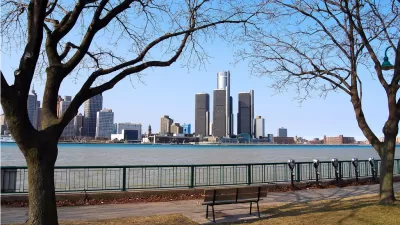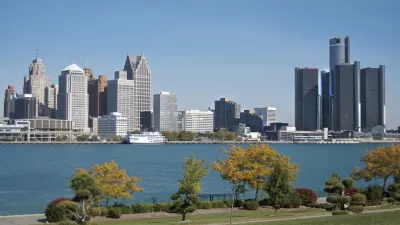A building under construction at the former site of J.L. Hudson's department store in Detroit will no longer reach 900 feet, as once planned.

"Detroit's planned tallest new building may no longer in fact be the city's tallest when it opens on the old Hudson's site in a few years," reports John Gallagher.
The planned height of the tower has fluctuated between 734 feet and 900 feet in the past. Now it's unclear what heights the building will end up reaching. Joe Guziewicz, vice president of construction for Bedrock LLC, the developer of the site, says the final height is dependent on the project eventually landing a hotel operator.
The height is likely lowering because of the developer's plans to "[switch] the programming of the planned skyscraper tower on the Hudson's site from all residential to partly a hotel […] depending on the needs of whatever hotel operator is chosen."
The changes also mean the building will no longer include an observation tower. The project is already under construction, and is now expected to open in 2023.
FULL STORY: Hudson's site tower may not be the city's tallest after all, Bedrock says

Planetizen Federal Action Tracker
A weekly monitor of how Trump’s orders and actions are impacting planners and planning in America.

Congressman Proposes Bill to Rename DC Metro “Trump Train”
The Make Autorail Great Again Act would withhold federal funding to the system until the Washington Metropolitan Area Transit Authority (WMATA), rebrands as the Washington Metropolitan Authority for Greater Access (WMAGA).

The Simple Legislative Tool Transforming Vacant Downtowns
In California, Michigan and Georgia, an easy win is bringing dollars — and delight — back to city centers.

DC Backpedals on Bike Lane Protection, Swaps Barriers for Paint
Citing aesthetic concerns, the city is removing the concrete barriers and flexposts that once separated Arizona Avenue cyclists from motor vehicles.

In These Cities, Most New Housing is Under 441 Square Feet
With loosened restrictions on “micro-housing,” tiny units now make up as much as 66% of newly constructed housing.

Albuquerque’s Microtransit: A Planner’s Answer to Food Access Gaps
New microtransit vans in Albuquerque aim to close food access gaps by linking low-income areas to grocery stores, cutting travel times by 30 percent and offering planners a scalable model for equity-focused transit.
Urban Design for Planners 1: Software Tools
This six-course series explores essential urban design concepts using open source software and equips planners with the tools they need to participate fully in the urban design process.
Planning for Universal Design
Learn the tools for implementing Universal Design in planning regulations.
Smith Gee Studio
City of Charlotte
City of Camden Redevelopment Agency
City of Astoria
Transportation Research & Education Center (TREC) at Portland State University
US High Speed Rail Association
City of Camden Redevelopment Agency
Municipality of Princeton (NJ)




























